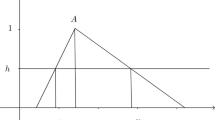Abstract
A simple method is proposed in this paper for estimating the fuzzy logistic regression model adopted with support vector machines. The proposed method is robust against the outliers in cases that the predictors are exact quantities and the responses are fuzzy data. For this purpose, the unknown center, left, and right spreads of fuzzy regression coefficients were estimated via a separated three-stage estimation procedure. The performance of the proposed method was also compared with similar methods in terms of some common goodness-of-fit criteria used in fuzzy regression analysis. The numerical results revealed that the proposed fuzzy (non-linear) logistic regression model can offer sufficiently accurate results compared to other methods.








Similar content being viewed by others
References
Akbari MG, Hesamian G (2019) A partial-robust-ridge-based regression model with fuzzy predictors-responses. J Comput Appl Math 351:290–301
Balasundaram S, Meena Y (2019) Robust support vector regression in primal with asymmetric Huber loss. Neural Process Lett 49:1399–1431
Coppi R, D’Urso P, Giordani P, Santoro A (2006) Least squares estimation of a linear regression model with \(LR\)-fuzzy response. Comput Stat Data Anal 51:267–286
Gao Y, Lu Q (2018) A fuzzy logistic regression model based on the least squares estimation. Comput Appl Math 37:3562–3579
Gu B, Sheng WS, Wang Z, Ho D, Osman S, Li S (2015) Incremental learning for v-support vector regression. Neural Netw 67:140–150
Gu B, Sheng WS, Tay KY, Romano R, Li S (2017) Cross validation through two-dimensional solution surface for cost-sensitive SVM. IEEE Trans Pattern Anal Mach Intell 39:1103–1121
Györfi L, Kohler M, Krzyzak A, Walk H (2002) A distribution-free theory of non-parametric regression. Springer, New York
Hastie T, Tibshirani R, Friedman J (2008) The elements of statistical learning. Springer, Berlin
Hesamian G, Akbari M (2017) Semi-parametric partially logistic regression model with exact inputs and intuitionistic fuzzy outputs. Appl Soft Comput 58:517–526
Hesamian G, Akbari MG, Asadollahi M (2017) Fuzzy semi-parametric partially linear model with fuzzy inputs and fuzzy outputs. Expert Syst Appl 71:230–239
Lee KH (2005) First course on fuzzy theory and applications. Springer, Berlin
Namdari M, Yoon JH, Abadi A, Taheri SM, Choi SH (2015) Fuzzy logistic regression with least absolute deviations estimators. Soft Comput 19:909917
Pourahmad S, Ayatollahi SMT, Taheri SM, Habib Agahi Z (2011a) Fuzzy logistic regression based on the least squares approach with application in clinical studies. Comput Math Appl 62:3353–3365
Pourahmad S, Ayatollahi SMT, Taheri SM (2011b) Fuzzy logistic regression: a new possibilistic model and its application in clinical vague status. Iran J Fuzzy Syst 8:1–17
Taheri SM, Abadi A, Namdari M, Esmaillzadeh A, Sarbakhsh P (2016) Using fuzzy logistic regression for modeling vague status situations: application to a dietary pattern study. Intell Decis Technol 10:183–192
Takemura K (2004) Fuzzy logistic regression analysis for fuzzy input–output data. In: The Proceedings of the second international symposium on soft computing and intelligent system
Tanaka H, Uejima S, Kiyoji A (1982) Linear regression analysis with fuzzy model. IEEE Trans Syst Man Cybern 12:903–907
Trott M (2004) The mathematica guidebook for programming. Springer, New York
Vapnik VN (1995) The nature of statistical learning theory. Springer, Berlin
Vapnik VN (1998) Statistical learning theory. Wiley, New York
Wasserman L (2007) All of non-parametric statistics. Springer, New York
Acknowledgements
The authors would like to thank the editor and anonymous reviewers for their constructive suggestions and comments, which improved the presentation of this work.
Author information
Authors and Affiliations
Corresponding author
Additional information
Publisher's Note
Springer Nature remains neutral with regard to jurisdictional claims in published maps and institutional affiliations.
Appendix: Tables
Appendix: Tables
See Tables 4, 5, 6, 7, 8, and 9.
Rights and permissions
About this article
Cite this article
Hesamian, G., Akbari, M.G. Support vector logistic regression model with exact predictors and fuzzy responses. J Ambient Intell Human Comput 14, 817–828 (2023). https://doi.org/10.1007/s12652-021-03333-3
Received:
Accepted:
Published:
Issue Date:
DOI: https://doi.org/10.1007/s12652-021-03333-3




